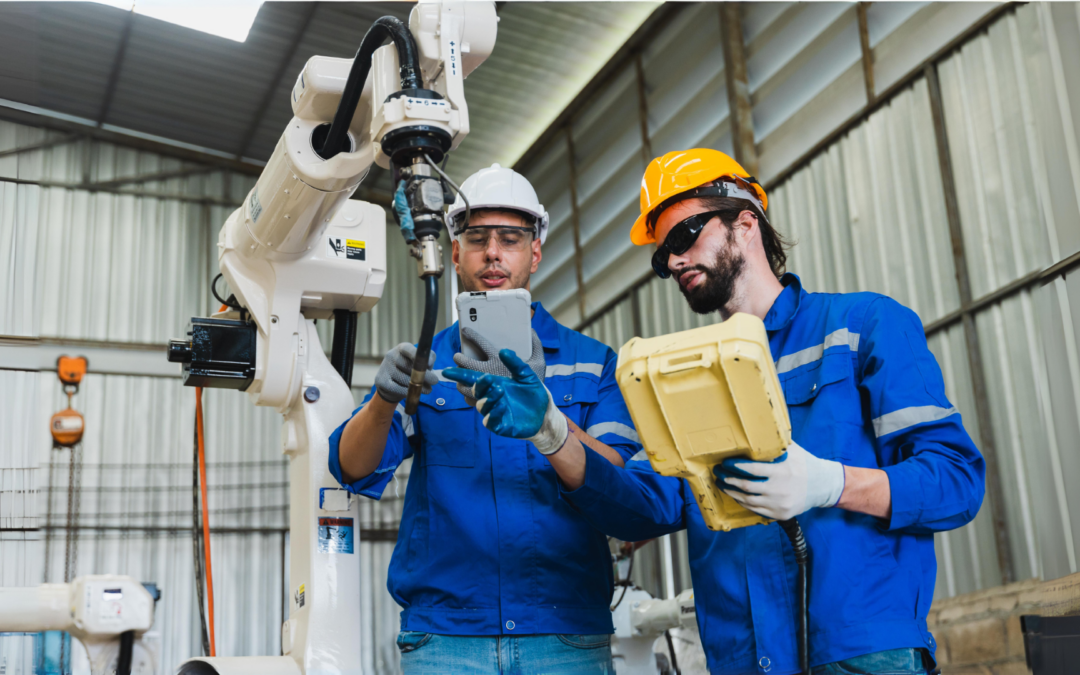It’s time to embrace the power of CMMS software. A CMMS streamlines maintenance processes and provides key insights into your equipment performance.
By the end of this article, you’ll better understand how a CMMS could help optimize your facilities and maintenance processes.
What is CMMS?
CMMS stands for “Computerized Maintenance Management System.” It is a software solution designed to digitize and simplify maintenance management.
By digitizing and automating maintenance processes, CMMS software helps maintenance teams streamline their operations, reduce downtime, and extend the lifespan of assets.
In the past, maintenance professionals relied on pen and paper or spreadsheets to manage maintenance tasks. But the game has changed. With CMMS software, you can say goodbye to the clutter and headaches of manual maintenance tracking.
It allows you to automate work orders, monitor asset performance, and efficiently manage your maintenance teams.
Why Do Maintenance Managers Need CMMS Software?
Adopting CMMS software is essential for efficiently managing the maintenance and upkeep of various assets within a company. Without a CMMS, maintaining and managing multiple assets becomes more complex and difficult. Here are the main reasons why you need CMMS software:
-
- Improved Maintenance Planning and Execution: CMMS software allows maintenance managers to plan and schedule maintenance tasks efficiently. They can prioritize work orders based on urgency, allocate resources effectively, and ensure timely completion of tasks. This leads to optimized maintenance planning and execution, reducing downtime and increasing productivity.
- Accurate Data and Meaningful Reports: CMMS software digitizes relevant reports, logs, and checklists, eliminating manual data entry and reducing errors. It provides maintenance teams with accurate and consistent data, enabling them to generate meaningful reports and make data-driven decisions. This improves transparency, facilitates performance evaluation, and contributes to continuous improvement.
- Increased Reliability and Extended Lifespan: Regular maintenance, facilitated by a CMMS, improves reliability and extends the lifespan of the equipment. By implementing preventive maintenance strategies, maintenance managers can identify potential issues early and take corrective actions to prevent major breakdowns. This results in increased equipment reliability and reduced need for expensive replacement parts.
- Simplified Work Order Management: A CMMS simplifies the management of work orders by providing a centralized database for all tasks. Maintenance managers can create, assign, and monitor work orders, improving workflow efficiency. Automated workflows enable the generation of work instructions and orders, facilitating resource allocation and traceability.
- Better Communication and Collaboration: CMMS software enhances communication and collaboration within maintenance teams. It reduces delays and misunderstandings by providing a centralized platform for task assignments, progress updates, and completed work notifications. This improves coordination and ensures efficient workflow management.
- Real-Time Insights: CMMS software provides real-time data and performance metrics for immediate decision-making and continuous improvement. Maintenance managers can access up-to-date information on asset maintenance history, performance trends, and resource allocation. This allows them to make informed decisions and implement proactive maintenance strategies.
The CMMS Market: Rising Opportunities
The CMMS market continuously evolves and expands, with new industries recognizing the benefits of adopting CMMS software. Traditionally, CMMS systems were limited to desktop applications used by industrial companies and large corporations.
However, advancements in cloud-based technologies have allowed CMMS providers to develop web-based, less complex software for small and medium-sized enterprises.
The demand for CMMS software has led to an increase in the number of providers and an expanded range of functionalities. The market caters to various industries, including service-based companies, healthcare facilities, and educational institutions.
CMMS software has evolved over the past decade to assist companies in utilizing their assets and boosting productivity.
The Downsides of Not Having CMMS
The lack of CMMS software can negatively impact maintenance processes and overall business operations. Here are some disadvantages of operating without CMMS:
-
- Lost of Sticky Notes: Manual methods such as sticky notes for maintenance planning can lead to lost or misplaced notes. This can easily result in missed tasks and disorganized maintenance processes.
- Time-Consuming Excel Spreadsheets: Manually entering maintenance data into Excel spreadsheets is time-consuming and prone to human errors. It also makes it difficult to evaluate and optimize maintenance processes effectively.
- Error-Prone Paper and Pen Maintenance Planning: Relying on pen and paper for maintenance planning is error-prone and inefficient compared to a digital CMMS solution. Paper-based systems lack the automation and data accuracy provided by CMMS software.
- Decreased Morale and Frustration: Outdated maintenance systems can decrease morale and frustration, especially among younger professionals. The lack of modern technologies and tools lowers job satisfaction and engagement.
The Advantages of Using CMMS: The Key to Digital Maintenance
1. Work Order Management
- Traditional Method: Manual work order management often involved paper forms and physical logbooks. Using this method, there was a high risk of human error, such as misplacing documents or miscommunications.
- CMMS Solution: A CMMS streamlines this process through electronic work order creation, assignment, tracking, and closure. It enhances communication, ensures accountability, and provides a clear audit trail.
2. Preventive Maintenance Scheduling
- Traditional Method: Preventive maintenance was often scheduled manually using calendars or spreadsheets, leading to missed maintenance activities and suboptimal equipment performance.
- CMMS Solution: Automating preventive maintenance scheduling with a CMMS ensures timely routine checks. It reduces equipment failures and extends asset life by adhering to optimal maintenance schedules.
3. Inventory Management
- Traditional Method: Manual inventory tracking, often using spreadsheets or physical ledgers, was time-consuming and susceptible to errors, leading to stock discrepancies.
- CMMS Solution: A CMMS provides real-time inventory management, automatic reordering triggers, and detailed tracking of parts usage. This precise management minimizes stockouts and excessive inventory.
4. Asset Tracking and Management
- Traditional Method: Manual asset tracking was inefficient and often led to incomplete or outdated asset information.
- CMMS Solution: CMMS platforms offer comprehensive asset management, including maintenance history, performance metrics, and depreciation tracking. This holistic view optimizes asset utilization and investment decisions.
5. Reporting and Analysis
- Traditional Method: Maintenance reports were manually generated, resulting in unclear data and insufficient time for decision-making.
- CMMS Solution: With built-in analytics and reporting tools, CMMS generates precise, real-time reports and dashboards, offering insights for strategic planning and continuous improvement.
6. Maintenance Cost Tracking
- Traditional Method: Tracking maintenance costs manually, often through receipts and manual logs, was chaotic and lacked analytical depth.
- CMMS Solution: CMMS platforms facilitate detailed tracking of maintenance costs, including labor, parts, and indirect expenses. This helps in accurate budgeting and financial analysis.
7. Safety Compliance
- Traditional Method: Ensuring compliance with safety regulations manually often led to documentation gaps and difficulty tracking compliance status.
- CMMS Solution: A CMMS maintains accurate records of safety inspections, procedures, and compliance-related tasks, simplifying adherence to regulatory standards and reducing liability risks.
8. Vendor and Contractor Management
- Traditional Method: Managing external vendors and contractors manually was fragmented and lacked consistency, impacting service quality.
- CMMS Solution: CMMS consolidates vendor management, tracking contracts, performance, and communication, leading to better coordination and quality of external services.
9. Audit Preparation
- Traditional Method: Manual audit preparation was cumbersome and time-consuming, often resulting in inadequate documentation.
- CMMS Solution: CMMS organizes and maintains all necessary maintenance records and documentation, making audit preparation systematic and less stressful.
10. Energy Management
- Traditional Method: Manual energy usage tracking was complex and often lacked precision, hindering effective energy management strategies.
- CMMS Solution: CMMS can monitor, report, and analyze energy consumption, aiding in identifying inefficiencies and opportunities for sustainable practices.
The Future of CMMS
The continuous evolution of CMMS – integrating with emerging technologies like the Internet of Things (IoT), artificial intelligence (AI), and predictive analytics – promises even greater advancements. This integration will further streamline maintenance processes, predict equipment failures before they occur, and optimize maintenance strategies for the future.
Embracing CMMS
For organizations still relying on traditional maintenance management methods, the transition to CMMS is not just an upgrade – it’s a strategic imperative. CMMS ensures operational excellence and long-term sustainability in an increasingly competitive and technologically advanced business landscape.
Conclusion
The adoption of a CMMS represents a paradigm shift in maintenance management. By replacing traditional manual processes with automated, data-driven solutions, CMMS enhances operational efficiency, reduces costs, and improves asset longevity. This technology empowers organizations to make informed decisions, ensure compliance, and foster a culture of continuous improvement in maintenance practices.
















